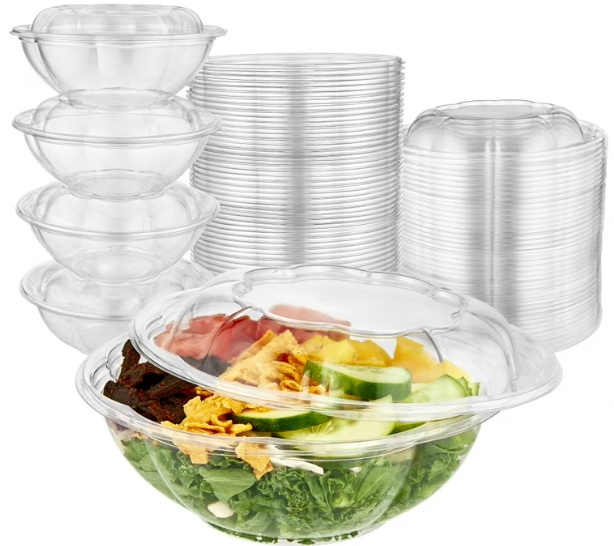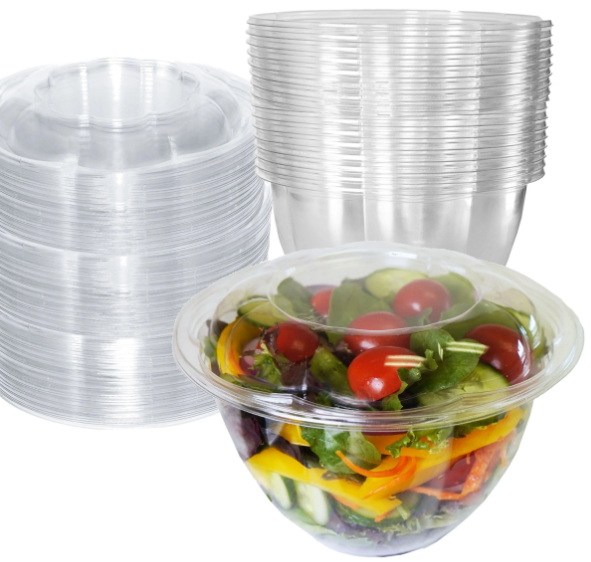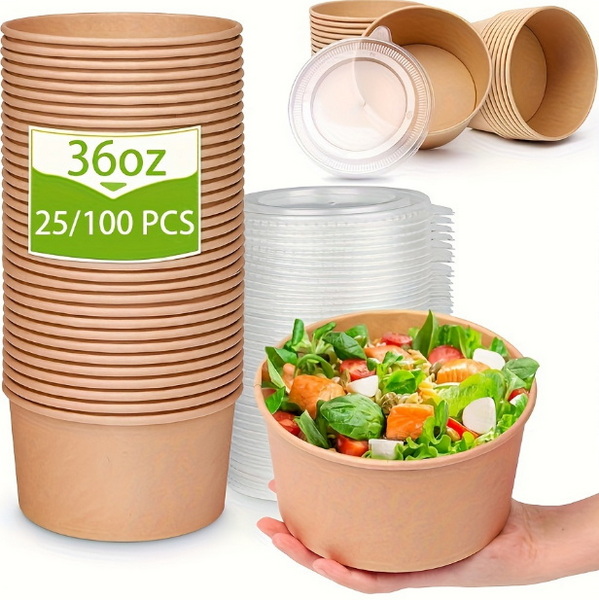
Content Menu
● Introduction to Disposable Bowls with Lids
>> Benefits of Disposable Bowls with Lids
● Materials for Disposable Bowls with Lids
>> 1. Plastic Disposable Bowls
>> 2. Paper Disposable Bowls
>> 3. PLA (Polylactic Acid) Disposable Bowls
>> 4. Cornstarch Disposable Bowls
>> 5. Bagasse Disposable Bowls
● Size and Capacity
● Eco-Friendliness
● Where to Buy Disposable Bowls with Lids
● Tips for Using Disposable Bowls with Lids
● Creative Uses for Disposable Bowls
● Multi-Compartment Disposable Bowls
● Lids for Disposable Bowls
● Environmental Considerations
● Conclusion
● FAQs
>> 1. What are the benefits of using disposable bowls with lids?
>> 2. What materials are disposable bowls with lids made from?
>> 3. Are all disposable bowls with lids microwave safe?
>> 4. How do I choose the right size of disposable bowl with lid?
>> 5. Where can I buy disposable bowls with lids?
● Citations:
Choosing the right disposable bowls with lids can be a daunting task, especially with the numerous options available in the market. Whether you are planning a picnic, hosting a party, or simply looking for convenient meal solutions, disposable bowls with lids are an excellent choice. They offer convenience, safety, and hygiene, making them perfect for both personal and commercial use. In this article, we will explore the key factors to consider when selecting the best disposable bowls with lids, including material, size, eco-friendliness, and more.

Introduction to Disposable Bowls with Lids
Disposable bowls with lids have become increasingly popular due to their ease of use and the convenience they offer. They are ideal for serving hot soups, stews, curries, and even cold dishes like salads. These bowls are available in various materials, including plastic, paper, PLA (Polylactic Acid), cornstarch, and bagasse, each with its unique benefits and drawbacks.
Benefits of Disposable Bowls with Lids
1. Convenience: Disposable bowls eliminate the need for washing and storing, making them perfect for on-the-go meals and events where cleanup is a concern.
2. Safety and Hygiene: They prevent contamination by ensuring each serving is in a new, clean container.
3. Versatility: Suitable for a wide range of dishes, from soups to salads.
Materials for Disposable Bowls with Lids
The choice of material is crucial when selecting disposable bowls with lids. Here are some of the most common materials:
1. Plastic Disposable Bowls
- Pros: Durable, resistant to hot liquids, and widely available.
- Cons: Not biodegradable, contributes to plastic waste.
2. Paper Disposable Bowls
- Pros: Eco-friendly, compostable, and affordable.
- Cons: May become soggy with hot liquids.
3. PLA (Polylactic Acid) Disposable Bowls
- Pros: Compostable, made from renewable resources.
- Cons: Not suitable for high temperatures.
4. Cornstarch Disposable Bowls
- Pros: Biodegradable, eco-friendly.
- Cons: May lose structural integrity with hot liquids.
5. Bagasse Disposable Bowls
- Pros: Compostable, strong construction, suitable for hot liquids.
- Cons: Availability may be limited compared to plastic.
Size and Capacity
Disposable bowls with lids come in various sizes, typically ranging from 8 oz to 32 oz. The size you choose should match the portion of food you plan to serve. For example, smaller bowls are ideal for appetizers or side dishes, while larger bowls are better suited for hearty meals or sharing portions.
Eco-Friendliness
For those concerned about environmental impact, eco-friendly disposable bowls with lids are a great option. Materials like bagasse, cornstarch, and PLA are biodegradable and compostable, reducing waste and supporting sustainable practices.
Where to Buy Disposable Bowls with Lids
Disposable bowls with lids can be purchased from various retailers, both online and offline. Online platforms like Amazon offer a wide selection with customer reviews, while local grocery stores and wholesale outlets provide convenient options for bulk purchases.
Tips for Using Disposable Bowls with Lids
1. Choose the Right Size: Ensure the bowl is large enough to hold your food without overfilling, which can lead to leaks or spills. On the other hand, if the bowl is too large, the food will move around and potentially become unappetizing[1].
2. Layering Technique: When packing salads or other foods with different ingredients, use the layering technique. This helps keep the food fresh and prevents ingredients from becoming soggy. Begin by placing heavier ingredients at the bottom of the bowl and lighter ingredients on top[1].
3. Prevent Overfilling: Avoid overfilling the bowl. Fill it to a level that leaves some space between the food and the lid to prevent spills and ensure the lid fits securely[1].
4. Label the Bowl: Labeling the bowl helps identify the contents, making it easier to know what food product is inside. Labeling can be done with a marker pen or using a label maker[1].
5. Secure Transportation: When transporting the bowl, ensure it is secured properly. Place the bowl in a lunchbox or wrap it in a towel to add extra padding and prevent spills[1].

Creative Uses for Disposable Bowls
Beyond their primary use for serving food, disposable bowls can be creatively repurposed for various activities:
- Crafts and Organization: Use disposable bowls to organize craft supplies, store travel snacks, or even make DIY pet food dishes[6].
- Desserts and Dips: Disposable small bowls are perfect for serving desserts like mousse or parfaits and dips such as guacamole or salsa. They provide a stylish presentation and easy cleanup[6].
- Kids' Meals: These bowls make mealtime fun for kids by offering portion control and easy cleanup. They are ideal for creative meal ideas like a mini taco bar or build-your-own fruit salad[6].
Multi-Compartment Disposable Bowls
For added convenience, multi-compartment disposable bowls are available. These bowls, often referred to as MultiBowls, feature divided sections that allow for serving multiple items in one container. They are ideal for sampling different foods or condiments without needing multiple bowls[2].
Lids for Disposable Bowls
The type of lid used with disposable bowls is also important. Options include paper lids, PET lids, PP lids, and biodegradable PLA lids. Each type of lid has its own advantages, such as heat resistance or eco-friendliness[3].
Environmental Considerations
As concern for the environment grows, choosing eco-friendly disposable bowls with lids becomes increasingly important. Biodegradable materials reduce waste and support sustainable practices, making them a preferred choice for environmentally conscious consumers[6].
Conclusion
Choosing the best disposable bowls with lids involves considering factors such as material, size, eco-friendliness, and convenience. Whether you opt for plastic, paper, or biodegradable options, these bowls offer a hassle-free way to enjoy meals without the worry of cleanup. With the right disposable bowl with lid, you can ensure a safe, hygienic, and enjoyable dining experience.

FAQs
1. What are the benefits of using disposable bowls with lids?
Disposable bowls with lids offer convenience, safety, and hygiene. They eliminate the need for washing and storing, making them ideal for on-the-go meals and events. They also prevent contamination by ensuring each serving is in a new, clean container.
2. What materials are disposable bowls with lids made from?
Disposable bowls with lids can be made from plastic, paper, PLA, cornstarch, and bagasse. Each material has its pros and cons, with plastic being durable but not eco-friendly, and biodegradable materials like bagasse and cornstarch offering sustainable options.
3. Are all disposable bowls with lids microwave safe?
Not all disposable bowls with lids are microwave safe. While some materials like plastic and certain paper bowls may be suitable for microwaving, others like PLA and cornstarch are not recommended for high temperatures.
4. How do I choose the right size of disposable bowl with lid?
Choose a size that matches the portion of food you plan to serve. Smaller bowls are ideal for appetizers, while larger bowls are better for hearty meals or sharing portions.
5. Where can I buy disposable bowls with lids?
Disposable bowls with lids can be purchased from online retailers like Amazon, local grocery stores, and wholesale outlets. Online platforms offer a wide selection with customer reviews, while local stores provide convenient options for bulk purchases.
Citations:
[1] https://www.agreenproducts.ca/safe-and-secure-packing-tips-for-using-disposable-bowls-with-lids/
[2] https://patents.google.com/patent/US20170013980A1/en
[3] https://www.yanxiyan.com/covers-for-paper-bowl/
[4] https://takethemameal.com/blog/container_ideas_for_taking_meals.php
[5] https://www.quill.com/disposable-bowls/cbl/27381.html
[6] https://www.innaturepack.com/creative-uses-for-disposable-small-bowls-dips-desserts-and-more/
[7] https://www.dayuplastic.com/news/industry-news/how-do-disposable-plastic-bowls-streamline-daily-routines-making-everyday-living-more-efficient.html
[8] https://www.uchampak.com/a-how-do-paper-bowl-lids-enhance-food-presentation.html
[9] https://www.replacethewaste.sa.gov.au/guideline-food-containers
[10] https://smartyhadaparty.com/blogs/home/fun-kids-disposable-dinnerware-ideas
[11] https://www.cd-case.com.tw/en/news/HWS-news-2023-01.html
[12] https://en.wikipedia.org/wiki/Disposable_food_packaging
[13] https://www.pinterest.com/ideas/paper-bowl/931860469708/
[14] https://multimedia.scmp.com/infographics/news/hong-kong/article/3259438/plastic-ban/index.html
[15] https://www.biopak.com/uk/containers-lids/bowls?p=2
[16] https://www.linkedin.com/pulse/best-disposable-paper-bowl-lids-to-go-food-sowinpak
[17] https://www.kimecopak.ca/blogs/news/how-are-paper-bowls-made
[18] https://www.kraftpaperbowls.com/sale-11673316-microwavable-and-freezer-disposable-bowls-with-lids-for-hot-food-safe-single-use.html
[19] https://www.pinterest.com/ideas/disposable-food-containers/958603893290/
[20] https://www.cd-case.com.tw/en/news/HWS-news-2023-02.html

















